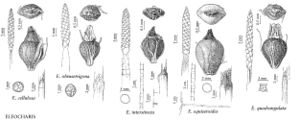Difference between revisions of "Eleocharis quadrangulata"
in J. J. Roemer et al., Syst. Veg. 2: 155. 1817.
FNA>Volume Importer |
FNA>Volume Importer |
||
| Line 11: | Line 11: | ||
|name=Scirpus quadrangulatus | |name=Scirpus quadrangulatus | ||
|authority=Michaux | |authority=Michaux | ||
| + | |rank=species | ||
|publication_title=Fl. Bor.-Amer. | |publication_title=Fl. Bor.-Amer. | ||
|publication_place=1: 30. 1803 | |publication_place=1: 30. 1803 | ||
| Line 17: | Line 18: | ||
|name=Eleocharis quadrangulata var. crassior | |name=Eleocharis quadrangulata var. crassior | ||
|authority=Fernald | |authority=Fernald | ||
| + | |rank=variety | ||
}} {{Treatment/ID/Synonym | }} {{Treatment/ID/Synonym | ||
|name=Scirpus albomarginatus | |name=Scirpus albomarginatus | ||
|authority=Muhlenberg | |authority=Muhlenberg | ||
| + | |rank=species | ||
}} {{Treatment/ID/Synonym | }} {{Treatment/ID/Synonym | ||
|name=Scirpus marginatus | |name=Scirpus marginatus | ||
| − | |authority= | + | |authority= |
| + | |rank=species | ||
}} | }} | ||
|hierarchy=Cyperaceae;Eleocharis;Eleocharis subg. Limnochloa;Eleocharis quadrangulata | |hierarchy=Cyperaceae;Eleocharis;Eleocharis subg. Limnochloa;Eleocharis quadrangulata | ||
| Line 48: | Line 52: | ||
-->{{#Taxon: | -->{{#Taxon: | ||
name=Eleocharis quadrangulata | name=Eleocharis quadrangulata | ||
| − | |||
|authority=(Michaux) Roemer & Schultes in J. J. Roemer et al. | |authority=(Michaux) Roemer & Schultes in J. J. Roemer et al. | ||
|rank=species | |rank=species | ||
| Line 63: | Line 66: | ||
|publication year=1817 | |publication year=1817 | ||
|special status= | |special status= | ||
| − | |source xml=https://jpend@bitbucket.org/aafc-mbb/fna-data-curation.git/src/ | + | |source xml=https://jpend@bitbucket.org/aafc-mbb/fna-data-curation.git/src/f50eec43f223ca0e34566be0b046453a0960e173/coarse_grained_fna_xml/V23/V23_183.xml |
|genus=Eleocharis | |genus=Eleocharis | ||
|subgenus=Eleocharis subg. Limnochloa | |subgenus=Eleocharis subg. Limnochloa | ||
Revision as of 20:05, 16 December 2019
Plants perennial; rhizomes 1.5–4 mm thick, soft to hard, longer internodes 3–8 cm, scales 5–10 mm, tubers absent. Culms acutely quadrangular, (30–)45–105 cm × (1–)2–5.4 mm, soft to firm, internally spongy, transverse septa incomplete; plants never forming filiform, flaccid culms. Leaves: distal leaf sheaths persistent, membranous, apex narrowly acute to acuminate, sometimes prolonged into a bladelike portion to 8 cm. Spikelets not proliferous, (15–)20–76 × 3–5(–6) mm; rachilla joints bearing obscure winglike remnants of floral scales; proximal scale empty, amplexicaulous, (1–)2.2–5.4 mm; floral scales (28–)45–135, 2–3 per mm of rachilla, stramineous to pale brown, usually with pale to dark brown submarginal band, midrib region sometimes greenish, broadly obovate to ovate, (4–)4.5–6.2 × 2.8–5 mm, subcartilaginous, apex rounded to obtuse. Flowers: perianth bristles 6–7, whitish to brown, slender, often markedly unequal, shorter than achene or some equalling tubercle, sparsely retrorsely spinulose to smooth; anthers stramineous to red-brown, 2.3–2.9 mm; styles 3-fid, sometimes 2-fid. Achenes yellow or pale green to brown or purplish, biconvex, obovoid to obpyriform, 1.8–3 × 1.3–2 mm, almost smooth to markedly sculptured at 10–15X, each face with 19–38 rows of almost linear, transversely elongated cells, which are sometimes isodiametric at achene base, apex often constricted to neck 0.3–0.4 mm wide. Tubercles dark brown or whitish, deltoid to high-pyramidal or lanceoloid, 0.7–1.5 × 0.4–1 mm, often spongy.
Phenology: Fruiting early summer–winter.
Habitat: Shallow water of fresh lake and pond shores, marshes
Elevation: 10–600 m
Distribution

Ont., Ark., Calif., Conn., Del., Fla., Ga., Ill., Ind., Ky., La., Mass., Mich., Miss., Mo., N.J., N.Y., N.C., Ohio, Okla., Oreg., Pa., S.C., Tex., Va., W.Va., Wis., s to c Mexico.
Discussion
We have not seen voucher specimens for the reports of Eleocharis quadrangulata from Kansas. Plants with greenish achenes, longer bristles, and longer anthers than the average are known from Tennessee.
The tubercles of Eleocharis quadrangulata are often spongy as in E. obtusetrigona.
Selected References
None.
